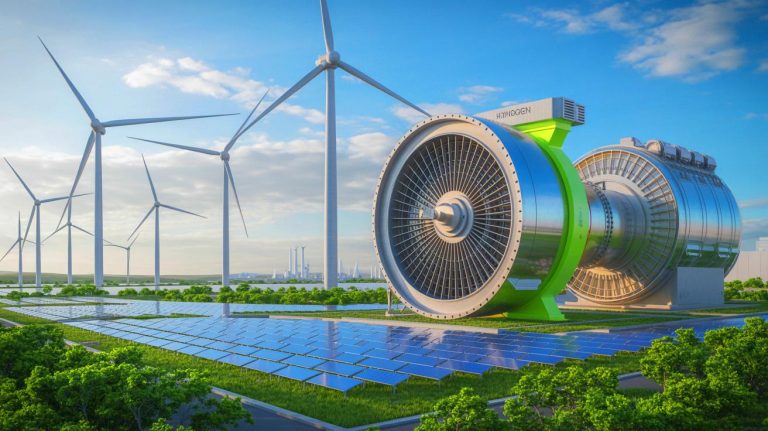| IN A NUTSHELL |
|
China is making waves in the global energy landscape with the construction of a groundbreaking 100% hydrogen turbine in Ordos, northern China. This project is not just another renewable energy initiative; it represents the world’s first large-scale hydrogen-fired generation system that integrates wind, solar, and hydrogen storage in a closed-loop cycle. Located in the Otoke High-Tech Industrial Development Zone, this development aims to demonstrate the feasibility and sustainability of hydrogen as a primary energy source. As China continues to push boundaries in renewable technology, this project may set a precedent for future hydrogen initiatives worldwide.
China’s Ambitious Hydrogen Initiative
China has embarked on an ambitious journey to revolutionize its energy infrastructure with the introduction of a 100% hydrogen turbine in Ordos. Unlike prior developments by Japan and Germany, this Chinese initiative is uniquely integrated with large-scale renewable sources. The turbine is part of the Ejingke wind-solar-hydrogen integrated green ammonia project, spearheaded by Mingyang Hydrogen and Shenzhen Energy. With a staggering 500MW wind capacity and 240MW of electrolysers, the setup is designed to produce around 4.3 tonnes of hydrogen per hour.
This project also includes a 5MW off-grid photovoltaic array and twelve massive storage tanks, each holding 1,875 cubic meters. Additionally, the facility is expected to produce 150,000 tonnes of green ammonia annually. The scale and integration of these components make the project a potential game-changer in the realm of renewable energy. By running solely on hydrogen, the turbine sets a new standard, showcasing the viability of hydrogen as a clean and efficient energy source.
An Innovative Closed-Loop Energy System
The core of this project lies in its innovative “electricity–hydrogen–electricity” closed-loop cycle. The concept is straightforward yet transformative. Renewable energy is converted into hydrogen, stored, and then used for electricity generation during periods of low renewable output. This cycle aims to address the intermittency issues faced by renewable energy sources, thereby stabilizing supply.
Inner Mongolia’s aspirations to become a national hydrogen energy demonstration hub are closely tied to this project. The initiative could serve as a blueprint for similar projects worldwide, integrating hydrogen into renewable-heavy grids. Despite some criticisms regarding energy losses in electrolysis, storage, and combustion, the project aims to showcase the potential of a comprehensive green hydrogen ecosystem. As China accelerates its efforts to lead the world in clean energy, the success of this project could have far-reaching implications.
China’s Commitment to Clean Energy
China’s commitment to renewable energy is evident in its “dual carbon” strategy, targeting peak carbon emissions by 2030 and carbon neutrality by 2060. The country aims to expand its wind and solar capacity to an impressive 1,200 GW by 2030. Recent reports indicate significant progress, with 198 GW of solar and 46 GW of wind capacity added between January and May this year alone. These figures are equivalent to the entire electricity output of countries like Indonesia or Turkey.
The hydrogen turbine project in Ordos is a critical component of this strategy, demonstrating China’s dedication to reducing CO2 emissions. By integrating hydrogen into its energy mix, China is positioning itself as a leader in the global transition to clean energy. As the world grapples with climate change and its impacts, China’s actions may influence other nations to adopt similar initiatives, promoting a more sustainable future.
Challenges and Future Prospects
While the potential of China’s hydrogen project is immense, it is not without challenges. Critics have pointed out the energy losses inherent in the processes of electrolysis, storage, and combustion. These losses could lead to higher energy costs, raising questions about the project’s economic viability. However, China remains undeterred, focusing on the long-term benefits of a sustainable energy ecosystem.
By building a comprehensive green hydrogen ecosystem, China aims to become a world leader in clean energy.
The project’s success could pave the way for similar initiatives across the globe, as countries seek to reduce their carbon footprints. The integration of hydrogen into renewable-heavy grids could be a crucial step in achieving global carbon neutrality. As the project progresses, it will be essential to monitor its impact and effectiveness in meeting its ambitious goals.
China’s hydrogen turbine project in Ordos represents a significant leap forward in the quest for sustainable energy solutions. By integrating hydrogen into a closed-loop system, the project could redefine the role of renewables in global energy markets. As China continues to innovate and expand its renewable capacity, the world watches closely. Will this pioneering effort spark a new era of hydrogen-based energy systems worldwide?
Did you like it? 4.5/5 (21)






Wow, this is huge! China is really stepping up in the clean energy game. 🌍